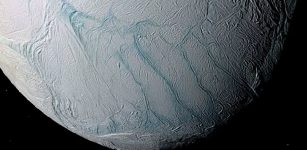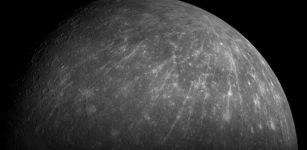Spotted Surface Of The North Star (Polaris) May Help Understand Evolution Of Stars Similar To Polaris
Eddie Gonzales Jr. – MessageToEagle.com – Researchers at Georgia State University’s CHARA Array have discovered new details about the North Star’s (Polaris) size and appearance.
Earth’s North Pole points to a direction in space marked by the North Star. Polaris is both a navigation aid and a remarkable star in its own right.
CHARA Array false-color image of Polaris from April 2021 that reveals large bright and dark spots on the surface. Polaris appears about 600,000 times smaller than the Full Moon in the sky.
It is the brightest member of a triple-star system and is a pulsating variable star. Polaris gets brighter and fainter periodically as the star’s diameter grows and shrinks over a four-day cycle.
Polaris is a kind of star known as a Cepheid variable. Astronomers use these stars as “standard candles” because their true brightness depends on their period of pulsation: Brighter stars pulsate slower than fainter stars. How bright a star appears in the sky depends on the star’s true brightness and the distance to the star. Because we know the true brightness of a Cepheid based on its pulsational period, astronomers can use them to measure the distances to their host galaxies and to infer the expansion rate of the universe.
A team of astronomers led by Nancy Evans at the Center for Astrophysics | Harvard & Smithsonian observed Polaris using the CHARA optical interferometric array of six telescopes at Mount Wilson, Calif. The goal of the investigation was to map the orbit of the close, faint companion that orbits Polaris every 30 years.
The CHARA Array is located at the Mount Wilson Observatory in the San Gabriel Mountains of southern California. The six telescopes of the CHARA Array are arranged along three arms. The light from each telescope is transported through vacuum pipes to the central beam combining lab. All the beams converge on the MIRC-X camera in the lab.
“The small separation and large contrast in brightness between the two stars makes it extremely challenging to resolve the binary system during their closest approach,” Evans said in a press release.
The CHARA Array combines the light of six telescopes that are spread across the mountaintop at the historic Mount Wilson Observatory. By combining the light, the CHARA Array acted like a 330-meter telescope to detect the faint companion as it passed close to Polaris. The observations of Polaris were recorded using the MIRC-X camera which was built by astronomers at the University of Michigan and Exeter University in the U.K. The MIRC-X camera has the remarkable ability to capture details of stellar surfaces.
The team successfully tracked the orbit of the close companion and measured changes in the size of the Cepheid as it pulsated. The orbital motion showed that Polaris has a mass five times larger than that of the Sun. The images of Polaris showed that it has a diameter 46 times the size of the Sun.
The biggest surprise was the appearance of Polaris in close-up images. The CHARA observations provided the first glimpse of what the surface of a Cepheid variable looks like.
“The CHARA images revealed large bright and dark spots on the surface of Polaris that changed over time,” said Gail Schaefer, director of the CHARA Array. The presence of spots and the rotation of the star might be linked to a 120-day variation in measured velocity.
“We plan to continue imaging Polaris in the future,” said John Monnier, an astronomy professor at the University of Michigan. “We hope to better understand the mechanism that generates the spots on the surface of Polaris.”
Written by Eddie Gonzales Jr. – MessageToEagle.com Staff Writer



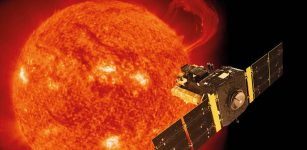

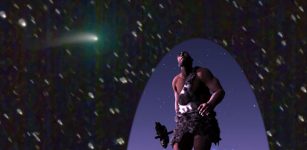
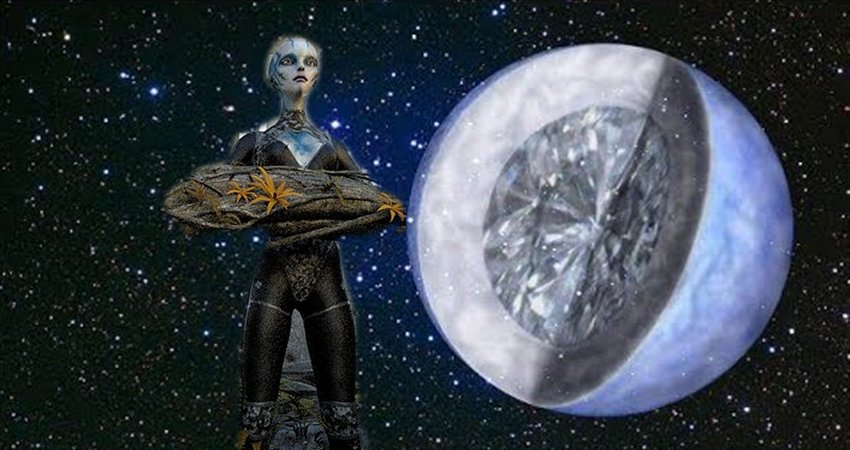
![127 18 Share Email Home Astronomy & Space Astronomy FEBRUARY 28, 2022 Kilonova afterglow potentially spotted for first time by Amanda Morris, Northwestern University An artist’s conception illustrates the aftermath of a 'kilonova,' a powerful event that happens when two neutron stars merge. Credit: NASA/CXC/M. Weiss For the first time, Northwestern University-led astronomers may have detected an afterglow from a kilonova. A kilonova occurs when two neutron stars—some of the densest objects in the universe—merge to create a blast 1,000 times brighter than a classical nova. In this case, a narrow, off-axis jet of high-energy particles accompanied the merger event, dubbed GW170817. Three-and-a-half years after the merger, the jet faded away, revealing a new source of mysterious X-rays. As the leading explanation for the new X-ray source, astrophysicists believe expanding debris from the merger generated a shock—similar to the sonic boom from a supersonic plane. This shock then heated surrounding materials, which generated X-ray emissions, known as a kilonova afterglow. An alternative explanation is materials falling toward a black hole—formed as a result of the neutron star merger—caused the X-rays. Either scenario would be a first for the field. The study was published today (Feb. 28), in The Astrophysical Journal Letters. "We have entered uncharted territory here in studying the aftermath of a neutron star merger," said Northwestern's Aprajita Hajela, who led the new study. "We are looking at something new and extraordinary for the very first time. This gives us an opportunity to study and understand new physical processes, which have not before been observed." Hajela is a graduate student at Northwestern's Center for Interdisciplinary Exploration and Research in Astrophysics (CIERA) and in the Department of Physics and Astronomy in the Weinberg College of Arts and Sciences. On Aug. 17, 2017, GW170817 made history as the first neutron-star merger detected by both gravitational waves and electromagnetic radiation (or light). Since then, astronomers have been using telescopes around the world and in space to study the event across the electromagnetic spectrum. Using NASA's Chandra X-ray Observatory, astronomers observed X-ray emissions from a jet moving very close to the speed of light produced by the neutron star merger. Starting in early 2018, the jet's X-ray emission steadily faded as the jet continued to slow and expand. Hajela and her team then noticed from March 2020 until the end of 2020, the decline in brightness stopped, and the X-ray emission was approximately constant in brightness. This was a significant clue. "The fact that the X-rays stopped fading quickly was our best evidence yet that something in addition to a jet is being detected in X-rays in this source," said Raffaella Margutti, astrophysicist at the University of California at Berkeley and a senior author of the study. "A completely different source of X-rays appears to be needed to explain what we're seeing." The researchers believe a kilonova afterglow or black hole are likely behind the X-rays. Neither scenario has ever before been observed. "This would either be the first time we've seen a kilonova afterglow or the first time we've seen material falling onto a black hole after a neutron star merger," said study co-author Joe Bright, also from the University of California at Berkeley. "Either outcome would be extremely exciting." To distinguish between the two explanations, astronomers will keep monitoring GW170817 in X-rays and radio waves. If it is a kilonova afterglow, the X-ray and radio emissions are expected to get brighter over the next few months or years. If the explanation involves matter falling onto a newly formed black hole, then the X-ray output should stay steady or decline rapidly, and no radio emission will be detected over time. "Further study of GW170817 could have far-reaching implications," said study co-author Kate Alexander, a CIERA postdoctoral fellow at Northwestern. "The detection of a kilonova afterglow would imply that the merger did not immediately produce a black hole. Alternatively, this object may offer astronomers a chance to study how matter falls onto a black hole a few years after its birth." Explore further Astronomers find x-rays lingering years after landmark neutron star collision More information: The emergence of a new source of X-rays from the binary neutron star merger GW170817, arXiv:2104.02070 [astro-ph.HE] arxiv.org/abs/2104.02070 Journal information: Astrophysical Journal Letters , Astrophysical Journal Provided by Northwestern University Facebook Twitter Email Feedback to editors Featured Last Comments Popular Commercial floor cleaners found to produce as much aerosol pollution particles as public roads 6 HOURS AGO 0 New brown dwarf discovered with TESS 7 HOURS AGO 0 Bitcoin carbon emissions rise as mining moves to US and other countries 7 HOURS AGO 4 Experimental evidence for long-distance electrodynamic intermolecular forces 7 HOURS AGO 0 3D micromesh-based hybrid printing for microtissue engineering FEB 25, 2022 0 Ancient oxygen levels provide clues to the timing of life and death on Earth 50 MINUTES AGO Climate change is causing high tree mortality in southern Amazon 52 MINUTES AGO Scaling laws in enzymes may help predict life 'as we don't know it' 53 MINUTES AGO Plastic labeling needs 'sustainability scale,' says new report 1 HOUR AGO Snail competition leads to fewer parasites that cause schistosomiasis 2 HOURS AGO Overlooked channels influence water flow and flooding along Gulf Coast 2 HOURS AGO Under pressure: A new theory helps predict when soft materials will fail 2 HOURS AGO Relevant PhysicsForums posts Standard way of expressing 'no proof given'? 1 HOUR AGO Really worried about the Ukraine 1 HOUR AGO Not getting anything in this subject Information system-: 1 HOUR AGO Is getting a Master's degree in physics worth it? 1 HOUR AGO Special Relativity violation via Quantum Mechanics? 1 HOUR AGO Kinematics - can't find the initial velocity according to the image 1 HOUR AGO More from Physics Forums | Science Articles, Homework Help, Discussion 1 2 Medical Xpress Medical research advances and health news Tech Xplore The latest engineering, electronics and technology advances Science X The most comprehensive sci-tech news coverage on the web Newsletters Email Science X Daily and the Weekly Email Newsletter are free features that allow you to receive your favorite sci-tech news updates in your email inbox Follow us Top Home Search Mobile version Help FAQ About Contact Science X Account Sponsored Account Archive News wire Android app iOS app RSS feeds Push notification © Phys.org 2003 - 2022 powered by Science X Network Privacy policy Terms of use 1 / 1An artist’s conception illustrates the aftermath of a 'kilonova,' a powerful event that happens when two neutron stars merge. Credit: NASA/CXC/M. Weiss](https://www.messagetoeagle.com/wp-content/uploads/2022/02/kilonova11-307x150.jpg)


